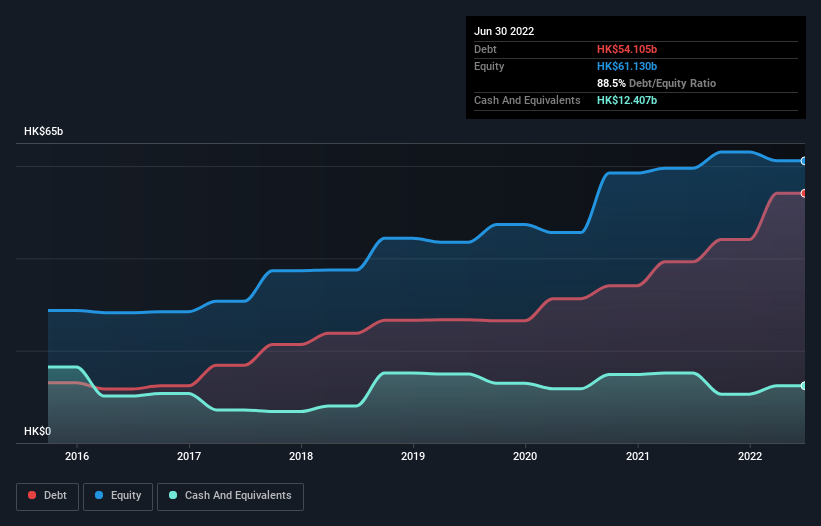- Hong Kong
- /
- Infrastructure
- /
- SEHK:152
Here's Why Shenzhen International Holdings (HKG:152) Is Weighed Down By Its Debt Load

David Iben put it well when he said, 'Volatility is not a risk we care about. What we care about is avoiding the permanent loss of capital.' So it seems the smart money knows that debt - which is usually involved in bankruptcies - is a very important factor, when you assess how risky a company is. As with many other companies Shenzhen International Holdings Limited (HKG:152) makes use of debt. But is this debt a concern to shareholders?
What Risk Does Debt Bring?
Debt and other liabilities become risky for a business when it cannot easily fulfill those obligations, either with free cash flow or by raising capital at an attractive price. If things get really bad, the lenders can take control of the business. However, a more common (but still painful) scenario is that it has to raise new equity capital at a low price, thus permanently diluting shareholders. By replacing dilution, though, debt can be an extremely good tool for businesses that need capital to invest in growth at high rates of return. The first step when considering a company's debt levels is to consider its cash and debt together.
View our latest analysis for Shenzhen International Holdings
What Is Shenzhen International Holdings's Debt?
The image below, which you can click on for greater detail, shows that at June 2022 Shenzhen International Holdings had debt of HK$54.1b, up from HK$39.3b in one year. On the flip side, it has HK$12.4b in cash leading to net debt of about HK$41.7b.

How Healthy Is Shenzhen International Holdings' Balance Sheet?
We can see from the most recent balance sheet that Shenzhen International Holdings had liabilities of HK$39.2b falling due within a year, and liabilities of HK$36.8b due beyond that. On the other hand, it had cash of HK$12.4b and HK$11.0b worth of receivables due within a year. So it has liabilities totalling HK$52.6b more than its cash and near-term receivables, combined.
This deficit casts a shadow over the HK$15.9b company, like a colossus towering over mere mortals. So we definitely think shareholders need to watch this one closely. After all, Shenzhen International Holdings would likely require a major re-capitalisation if it had to pay its creditors today.
We use two main ratios to inform us about debt levels relative to earnings. The first is net debt divided by earnings before interest, tax, depreciation, and amortization (EBITDA), while the second is how many times its earnings before interest and tax (EBIT) covers its interest expense (or its interest cover, for short). This way, we consider both the absolute quantum of the debt, as well as the interest rates paid on it.
Shenzhen International Holdings has net debt to EBITDA of 4.4 suggesting it uses a fair bit of leverage to boost returns. On the plus side, its EBIT was 7.3 times its interest expense, and its net debt to EBITDA, was quite high, at 4.4. Unfortunately, Shenzhen International Holdings saw its EBIT slide 2.5% in the last twelve months. If earnings continue on that decline then managing that debt will be difficult like delivering hot soup on a unicycle. The balance sheet is clearly the area to focus on when you are analysing debt. But it is future earnings, more than anything, that will determine Shenzhen International Holdings's ability to maintain a healthy balance sheet going forward. So if you want to see what the professionals think, you might find this free report on analyst profit forecasts to be interesting.
But our final consideration is also important, because a company cannot pay debt with paper profits; it needs cold hard cash. So it's worth checking how much of that EBIT is backed by free cash flow. Over the last three years, Shenzhen International Holdings saw substantial negative free cash flow, in total. While investors are no doubt expecting a reversal of that situation in due course, it clearly does mean its use of debt is more risky.
Our View
To be frank both Shenzhen International Holdings's conversion of EBIT to free cash flow and its track record of staying on top of its total liabilities make us rather uncomfortable with its debt levels. But at least it's pretty decent at covering its interest expense with its EBIT; that's encouraging. It's also worth noting that Shenzhen International Holdings is in the Infrastructure industry, which is often considered to be quite defensive. Taking into account all the aforementioned factors, it looks like Shenzhen International Holdings has too much debt. While some investors love that sort of risky play, it's certainly not our cup of tea. When analysing debt levels, the balance sheet is the obvious place to start. But ultimately, every company can contain risks that exist outside of the balance sheet. To that end, you should learn about the 4 warning signs we've spotted with Shenzhen International Holdings (including 1 which is significant) .
If, after all that, you're more interested in a fast growing company with a rock-solid balance sheet, then check out our list of net cash growth stocks without delay.
New: Manage All Your Stock Portfolios in One Place
We've created the ultimate portfolio companion for stock investors, and it's free.
• Connect an unlimited number of Portfolios and see your total in one currency
• Be alerted to new Warning Signs or Risks via email or mobile
• Track the Fair Value of your stocks
Have feedback on this article? Concerned about the content? Get in touch with us directly. Alternatively, email editorial-team (at) simplywallst.com.
This article by Simply Wall St is general in nature. We provide commentary based on historical data and analyst forecasts only using an unbiased methodology and our articles are not intended to be financial advice. It does not constitute a recommendation to buy or sell any stock, and does not take account of your objectives, or your financial situation. We aim to bring you long-term focused analysis driven by fundamental data. Note that our analysis may not factor in the latest price-sensitive company announcements or qualitative material. Simply Wall St has no position in any stocks mentioned.
About SEHK:152
Shenzhen International Holdings
An investment holding company, invests in, constructs, and operates logistics infrastructure facilities primarily in the People’s Republic of China.
Good value with proven track record and pays a dividend.
Market Insights
Community Narratives



